Page 267 of 703
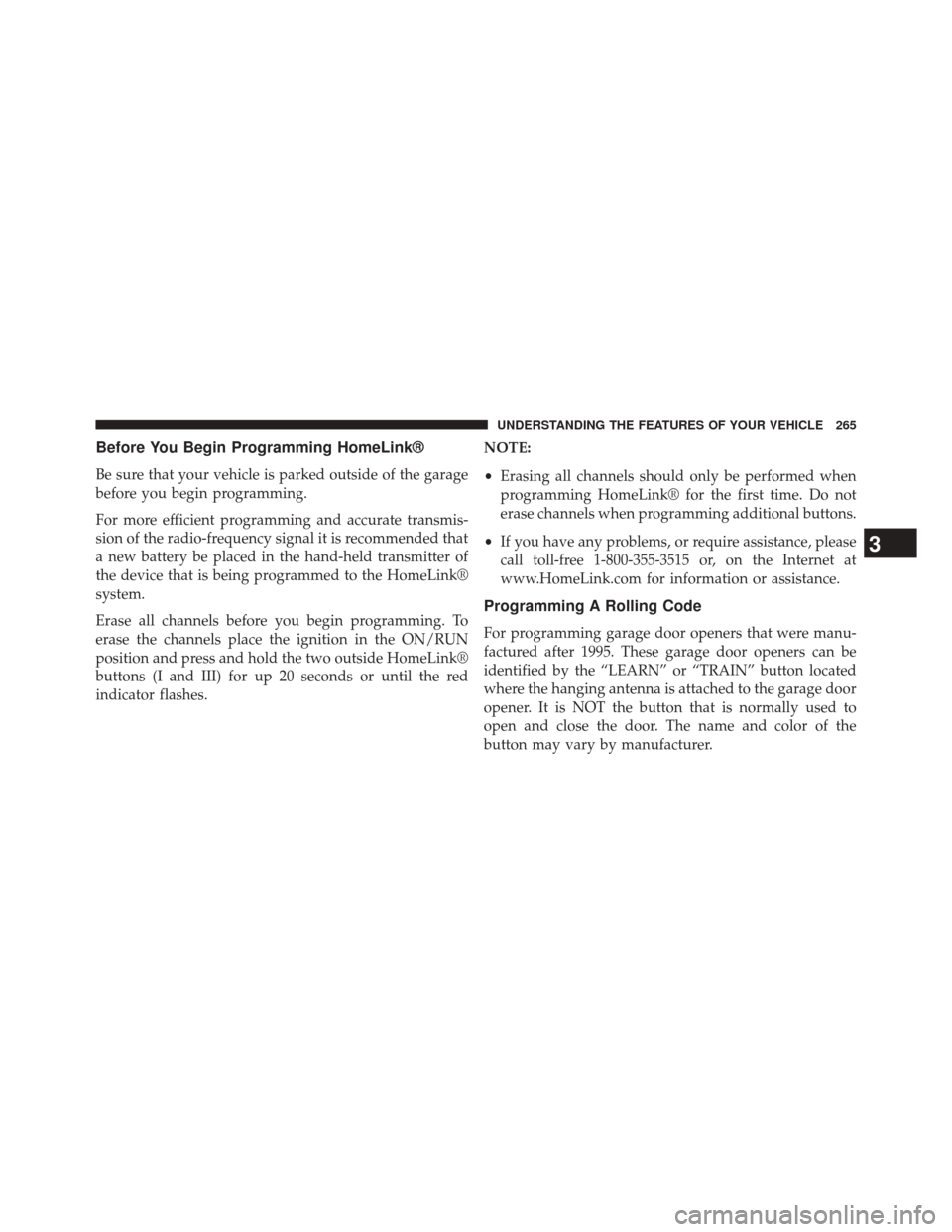
Before You Begin Programming HomeLink®
Be sure that your vehicle is parked outside of the garage
before you begin programming.
For more efficient programming and accurate transmis-
sion of the radio-frequency signal it is recommended that
a new battery be placed in the hand-held transmitter of
the device that is being programmed to the HomeLink®
system.
Erase all channels before you begin programming. To
erase the channels place the ignition in the ON/RUN
position and press and hold the two outside HomeLink®
buttons (I and III) for up 20 seconds or until the red
indicator flashes.NOTE:
•
Erasing all channels should only be performed when
programming HomeLink® for the first time. Do not
erase channels when programming additional buttons.
• If you have any problems, or require assistance, please
call toll-free 1-800-355-3515 or, on the Internet at
www.HomeLink.com for information or assistance.
Programming A Rolling Code
For programming garage door openers that were manu-
factured after 1995. These garage door openers can be
identified by the “LEARN” or “TRAIN” button located
where the hanging antenna is attached to the garage door
opener. It is NOT the button that is normally used to
open and close the door. The name and color of the
button may vary by manufacturer.
3
UNDERSTANDING THE FEATURES OF YOUR VEHICLE 265
Page 339 of 703
Wrong Key
Damaged Key
Key not programmed
Vehicle Not in Park
Key Left Vehicle
Key Not Detected
Press Brake Pedal and Push Button to Start
Liftgate Ajar (chime will sound when vehicle starts
moving)
Low Tire Pressure
Service TPM System (refer to “Tire Pressure Monitoring
System” in “Starting And Operating”)
Tire Pressure Screen With Low Tire(s) “Inflate Tire to XX”
Turn Signal OnRKE Battery Low
Service Keyless System
Low Washer Fluid
Oil Change Required
Check Gascap
Left Front Turn Signal Light Out
Left Rear Turn Signal Light Out
Right Front Turn Signal Light Out
Right Rear Turn Signal Light Out
Park Assist Disabled
Service Park Assist System
Personal Settings Not Available — Vehicle Not in Park
4
UNDERSTANDING YOUR INSTRUMENT PANEL 337
Page 460 of 703
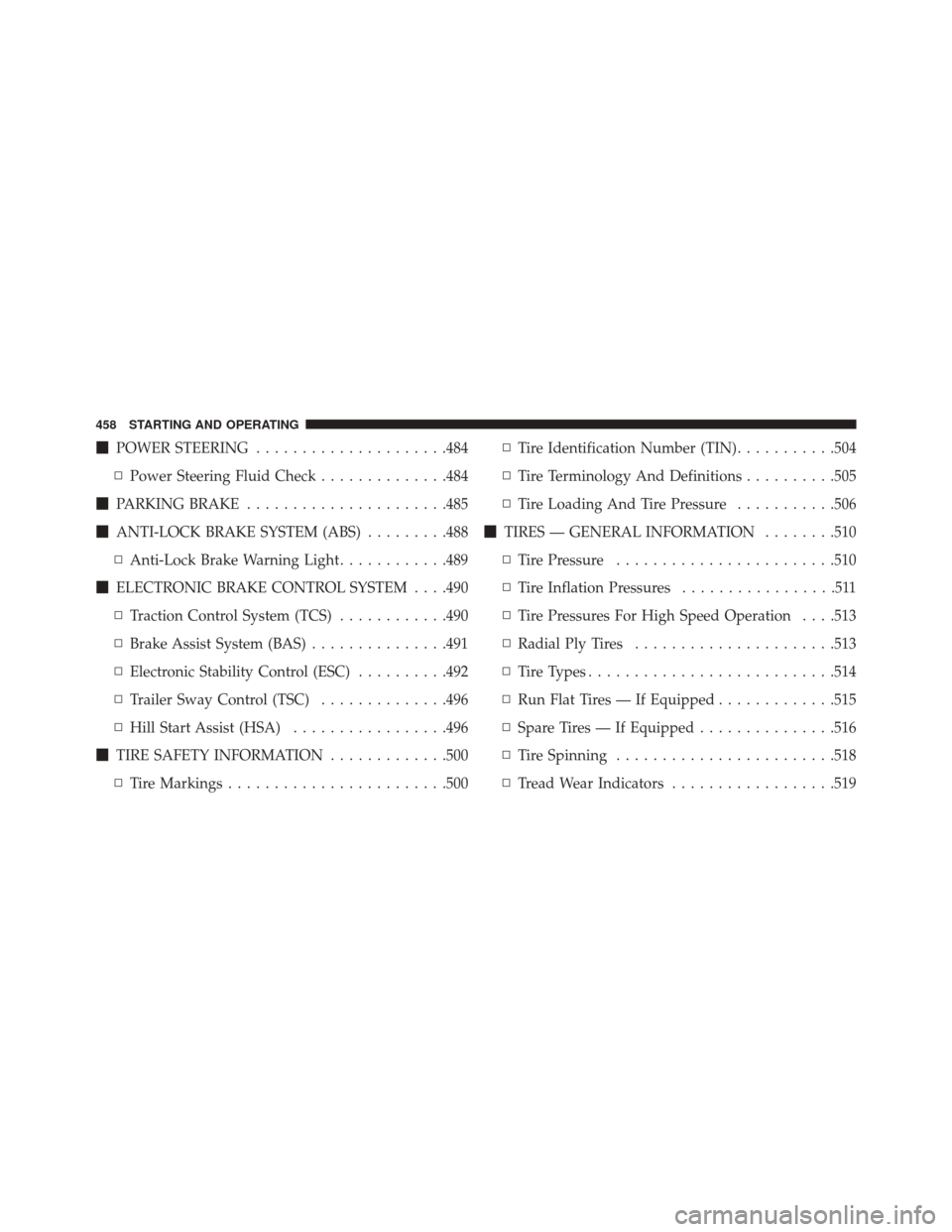
�POWER STEERING .....................484
▫ Power Steering Fluid Check ..............484
� PARKING BRAKE ..................... .485
� ANTI-LOCK BRAKE SYSTEM (ABS) .........488
▫ Anti-Lock Brake Warning Light ............489
� ELECTRONIC BRAKE CONTROL SYSTEM . . . .490
▫ Traction Control System (TCS) ............490
▫ Brake Assist System (BAS) ...............491
▫ Electronic Stability Control (ESC) ..........492
▫ Trailer Sway Control (TSC) ..............496
▫ Hill Start Assist (HSA) .................496
� TIRE SAFETY INFORMATION .............500
▫ Tire Markings ....................... .500▫
Tire Identification Number (TIN) ...........504
▫ Tire Terminology And Definitions ..........505
▫ Tire Loading And Tire Pressure ...........506
� TIRES — GENERAL INFORMATION ........510
▫ Tire Pressure ....................... .510
▫ Tire Inflation Pressures .................511
▫ Tire Pressures For High Speed Operation . . . .513
▫ Radial Ply Tires ..................... .513
▫ Tire Types .......................... .514
▫ Run Flat Tires — If Equipped .............515
▫ Spare Tires — If Equipped ...............516
▫ Tire Spinning ....................... .518
▫ Tread Wear Indicators ..................519
458 STARTING AND OPERATING
Page 486 of 703
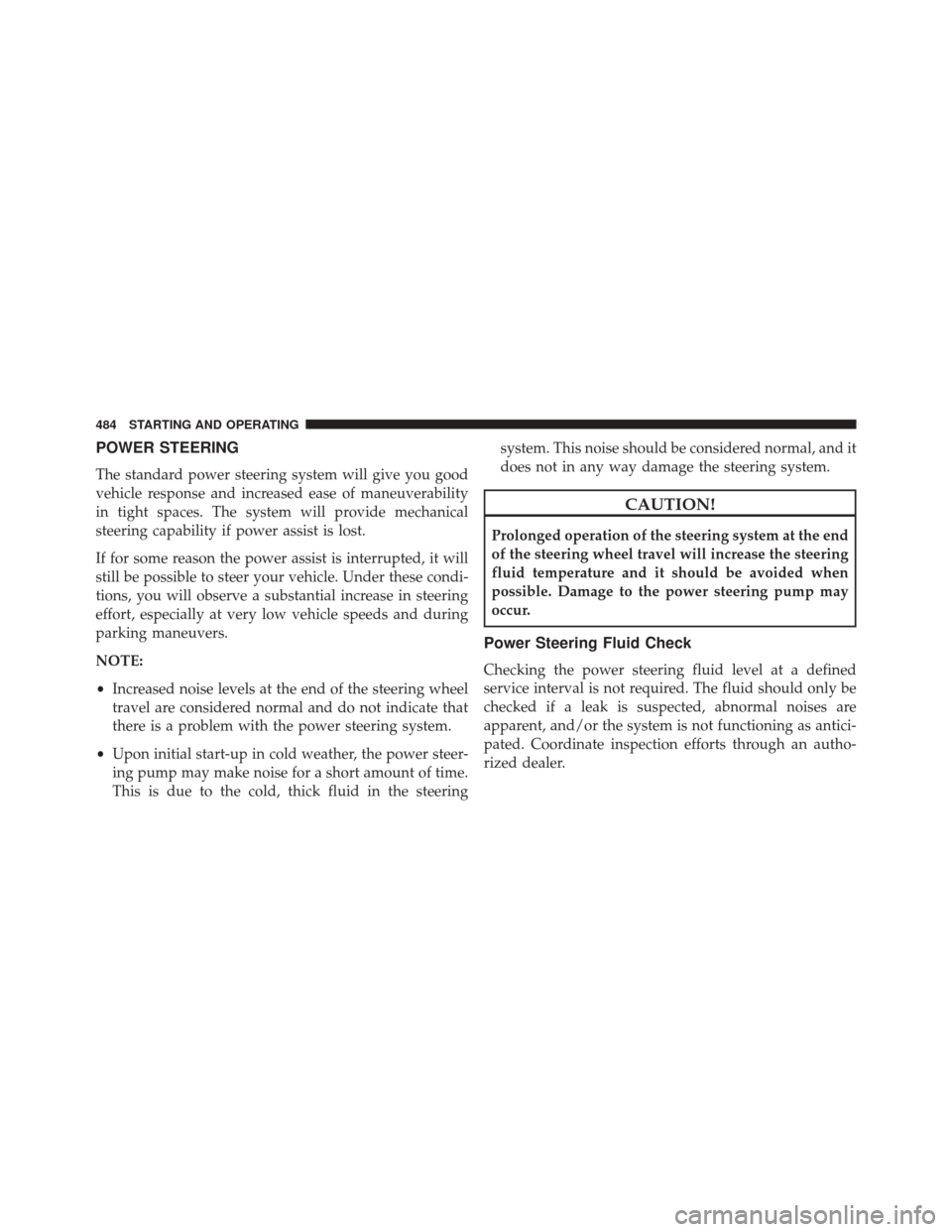
POWER STEERING
The standard power steering system will give you good
vehicle response and increased ease of maneuverability
in tight spaces. The system will provide mechanical
steering capability if power assist is lost.
If for some reason the power assist is interrupted, it will
still be possible to steer your vehicle. Under these condi-
tions, you will observe a substantial increase in steering
effort, especially at very low vehicle speeds and during
parking maneuvers.
NOTE:
•Increased noise levels at the end of the steering wheel
travel are considered normal and do not indicate that
there is a problem with the power steering system.
• Upon initial start-up in cold weather, the power steer-
ing pump may make noise for a short amount of time.
This is due to the cold, thick fluid in the steering system. This noise should be considered normal, and it
does not in any way damage the steering system.
CAUTION!
Prolonged operation of the steering system at the end
of the steering wheel travel will increase the steering
fluid temperature and it should be avoided when
possible. Damage to the power steering pump may
occur.
Power Steering Fluid Check
Checking the power steering fluid level at a defined
service interval is not required. The fluid should only be
checked if a leak is suspected, abnormal noises are
apparent, and/or the system is not functioning as antici-
pated. Coordinate inspection efforts through an autho-
rized dealer.
484 STARTING AND OPERATING
Page 500 of 703
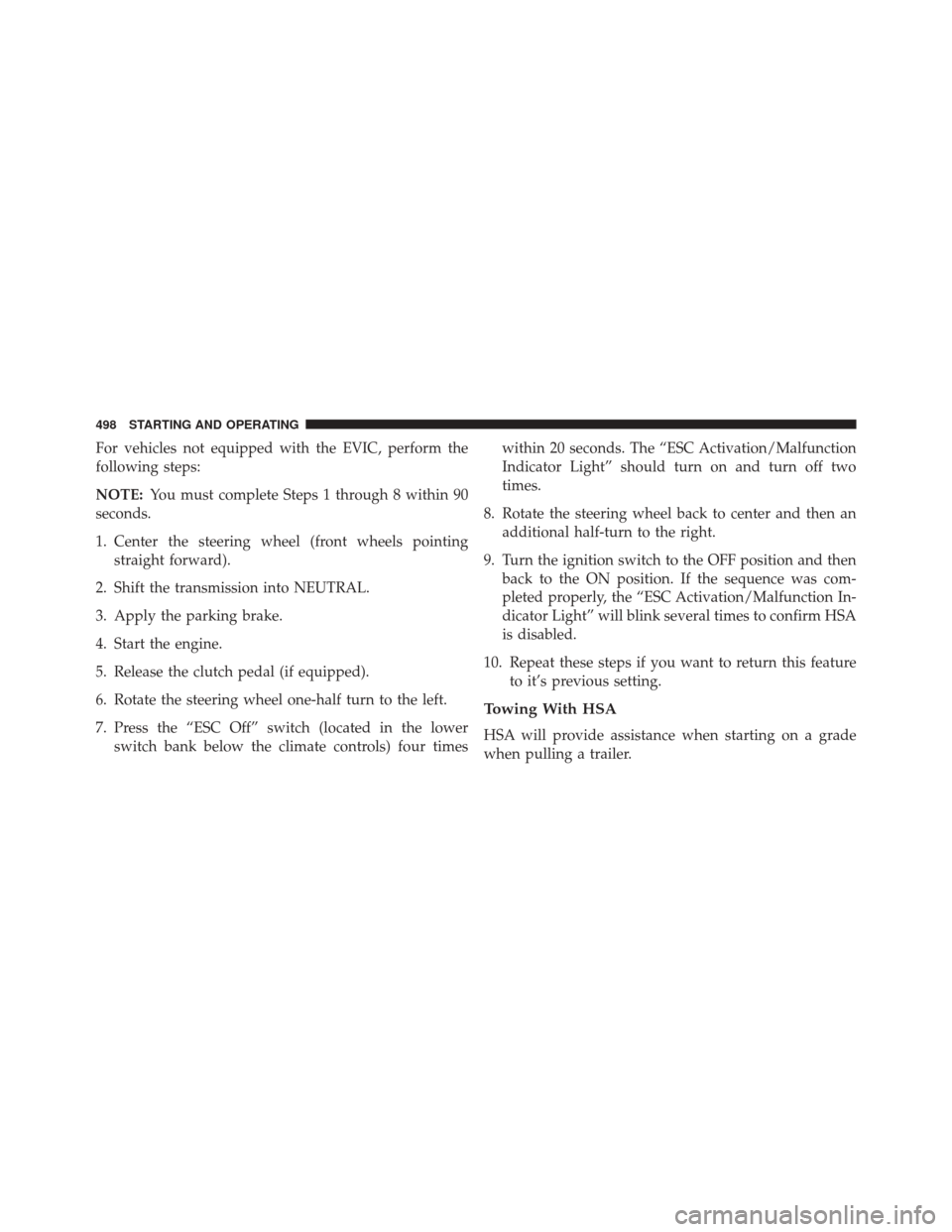
For vehicles not equipped with the EVIC, perform the
following steps:
NOTE:You must complete Steps 1 through 8 within 90
seconds.
1. Center the steering wheel (front wheels pointing straight forward).
2. Shift the transmission into NEUTRAL.
3. Apply the parking brake.
4. Start the engine.
5. Release the clutch pedal (if equipped).
6. Rotate the steering wheel one-half turn to the left.
7. Press the “ESC Off” switch (located in the lower switch bank below the climate controls) four times within 20 seconds. The “ESC Activation/Malfunction
Indicator Light” should turn on and turn off two
times.
8. Rotate the steering wheel back to center and then an additional half-turn to the right.
9. Turn the ignition switch to the OFF position and then back to the ON position. If the sequence was com-
pleted properly, the “ESC Activation/Malfunction In-
dicator Light” will blink several times to confirm HSA
is disabled.
10. Repeat these steps if you want to return this feature to it’s previous setting.
Towing With HSA
HSA will provide assistance when starting on a grade
when pulling a trailer.
498 STARTING AND OPERATING
Page 573 of 703
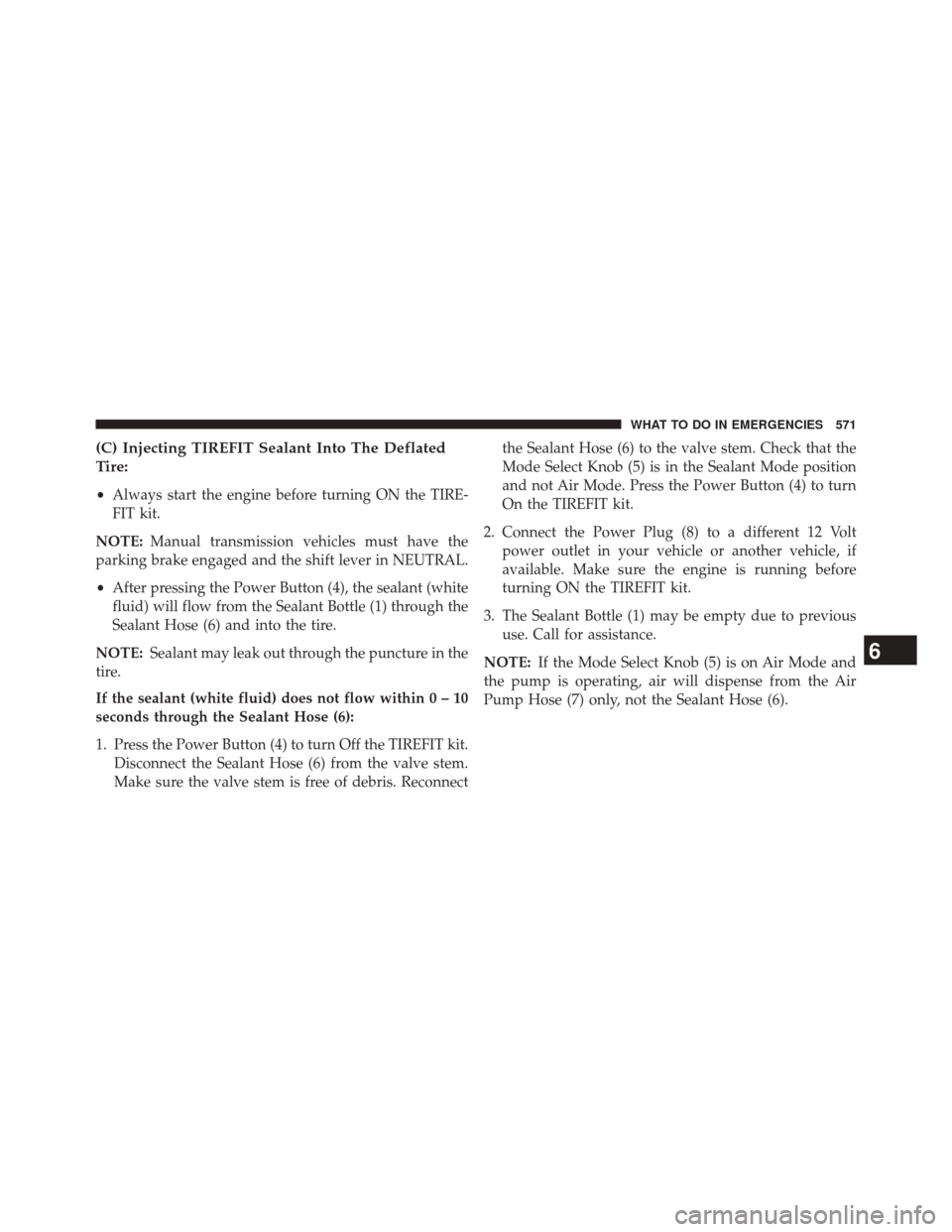
(C) Injecting TIREFIT Sealant Into The Deflated
Tire:
•Always start the engine before turning ON the TIRE-
FIT kit.
NOTE: Manual transmission vehicles must have the
parking brake engaged and the shift lever in NEUTRAL.
• After pressing the Power Button (4), the sealant (white
fluid) will flow from the Sealant Bottle (1) through the
Sealant Hose (6) and into the tire.
NOTE: Sealant may leak out through the puncture in the
tire.
If the sealant (white fluid) does not flow within0–10
seconds through the Sealant Hose (6):
1. Press the Power Button (4) to turn Off the TIREFIT kit. Disconnect the Sealant Hose (6) from the valve stem.
Make sure the valve stem is free of debris. Reconnect the Sealant Hose (6) to the valve stem. Check that the
Mode Select Knob (5) is in the Sealant Mode position
and not Air Mode. Press the Power Button (4) to turn
On the TIREFIT kit.
2. Connect the Power Plug (8) to a different 12 Volt power outlet in your vehicle or another vehicle, if
available. Make sure the engine is running before
turning ON the TIREFIT kit.
3. The Sealant Bottle (1) may be empty due to previous use. Call for assistance.
NOTE: If the Mode Select Knob (5) is on Air Mode and
the pump is operating, air will dispense from the Air
Pump Hose (7) only, not the Sealant Hose (6).
6
WHAT TO DO IN EMERGENCIES 571
Page 652 of 703
Cavity Cartridge Fuse Mini-FuseDescription
M27 —10 Amp Red Wireless Control Module, Keyless Entry Module
M28 —10 Amp Red Powertrain, Transmission Control Module
M29 —10 Amp Red Occupant Classification Module
M30 —15 Amp Blue Rear Wiper Module, Power Folding Mirror
M31 —20 Amp Yellow Back-Up Lamps
M32 —10 Amp Red Airbag Module, THATCHUM – If Equipped
M33 —10 Amp Red Powertrain
M34 —10 Amp Red Park Assist, Heater Climate Control Module,
Headlamp Wash, Compass, Rear Camera, Door
Lamps, Flashlight, Relay Diesel Cabin Heater, Rad Fan Diesel – If Equipped
M35 —10 Amp Red Heated Mirrors
M36 —20 Amp Yellow Power Outlet #3 (Instrument Panel or with
Console Center)
650 MAINTAINING YOUR VEHICLE
Page 683 of 703
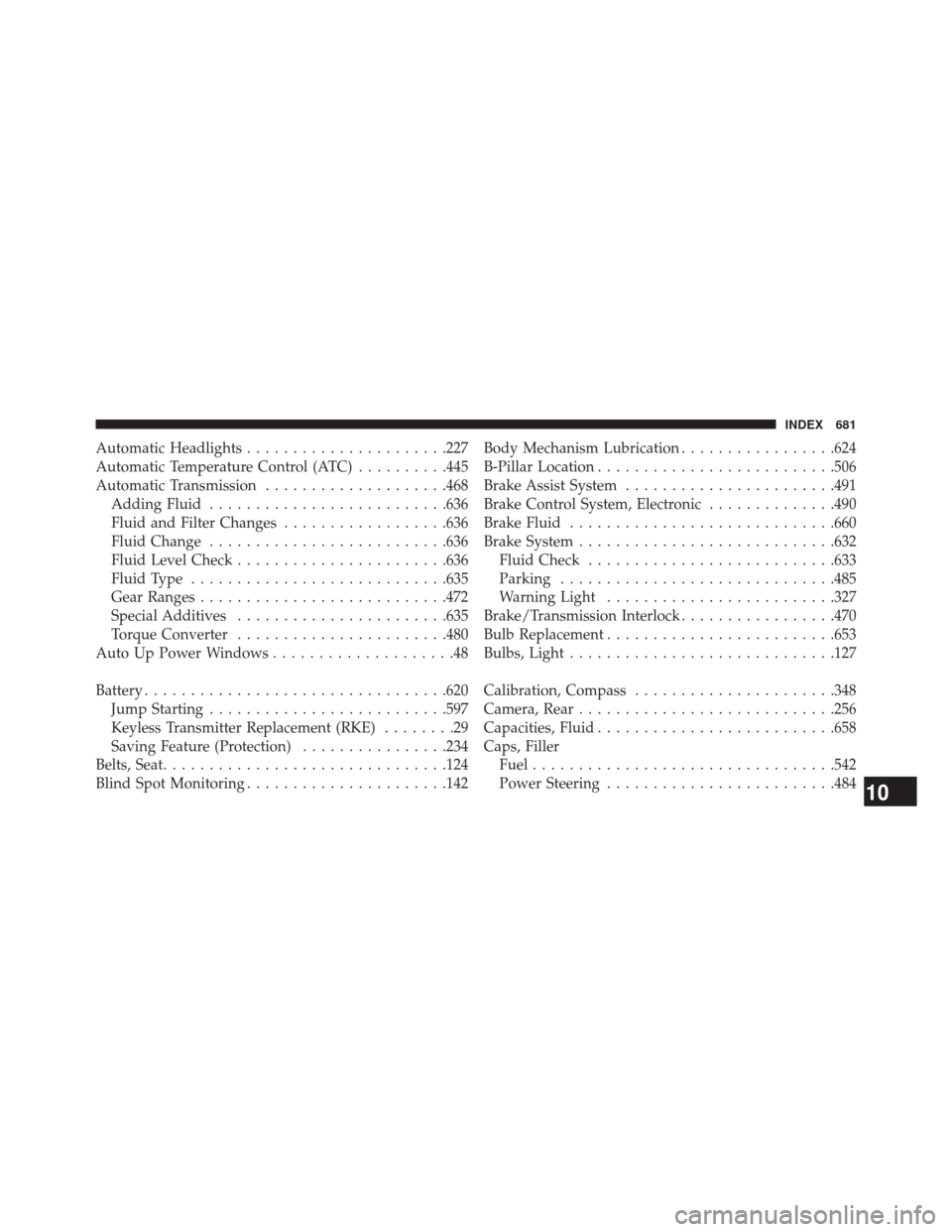
Automatic Headlights..................... .227
Automatic Temperature Control (ATC) ..........445
Automatic Transmission ....................468
Adding Fluid ......................... .636
Fluid and Filter Changes ..................636
Fluid Change ......................... .636
Fluid Level Check ...................... .636
Fluid Type ........................... .635
Gear Ranges .......................... .472
Special Additives ...................... .635
Torque Converter ...................... .480
Auto Up Power Windows ....................48
Battery ................................ .620
Jump Starting ......................... .597
Keyless Transmitter Replacement (RKE) ........29
Saving Feature (Protection) ................234
Belts, Seat .............................. .124
Blind Spot Monitoring ..................... .142Body Mechanism Lubrication
.................624
B-Pillar Location ......................... .506
Brake Assist System ...................... .491
Brake Control System, Electronic ..............490
Brake Fluid ............................ .660
Brake System ........................... .632
Fluid Check .......................... .633
Parking ............................. .485
Warning Light ........................ .327
Brake/Transmission Interlock .................470
Bulb Replacement ........................ .653
Bulbs, Light ............................ .127
Calibration, Compass ..................... .348
Camera, Rear ........................... .256
Capacities, Fluid ......................... .658
Caps, Filler Fuel ................................ .542
Power Steering ........................ .484
10
INDEX 681